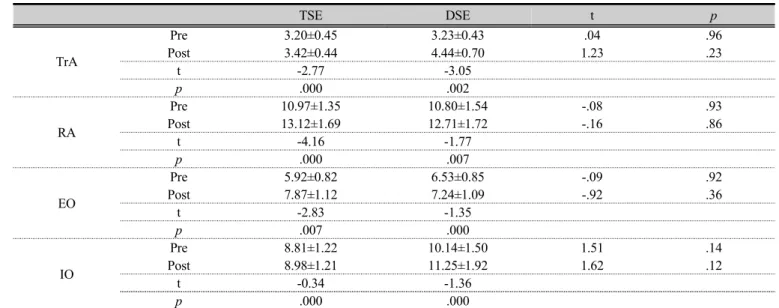호흡운동을 병행한 몸통 근력운동과 심부 안정화 운동이 배근육 두께와 호흡에 미치는 영향
김현수
1이건철
1ǂ추연기
21
경남정보대학교 물리치료과 교수, 구포성심병원 재활치료팀 팀장
Effect of Trunk Strength Exercise and Deep Stabilization Exercise Combined with Breathing Exercise on Abdominal Muscle Thickness and Respiration
Kim Hyeonsu, PT, Ph.D
1Lee Keoncheol, PT, Ph.D
1⧧Choo Yeonki, PT, Ph.D
21ǂ
Dept. of Physical Therapy, Kyungnam College of Information & Technology, Professor
2
Dept. of Rehabilitation Therapy, Guposungshim Hospital, Manager
Abstract
Purpose : The purpose of this study is to compare the effects on abdominal muscle thickness and breathing by applying trunk strength exercise and deep stabilization exercise along with breathing exercise, which is the main respiratory muscle during breathing, to present an efficient exercise method with diaphragm breathing.
Methods : This study was performed on normal 6 females and 14 males subjects. They were divided into 2 groups which trunk strength exercise and deep stabilization exercise group. The trunk strength exercise group (TSE) attended prone press-up, crunch and pelvic tiling. The deep stabilization exercise group (DSE) attended abdominal drawing, horizontal side-support and bridging exercise. Breathing exercise was performed for each set break time for 1 minute.
Results : First, in the comparison of the change in the thickness of the abdominal muscle between the trunk strength training group and the deep stabilization group before and after exercise, there was a statistically significant difference in the comparison of transverse abdominis (TrA), rectus femoris (RF), external oblique (EO), internal oblique (IO) (p<.05). However, there was no significant difference in any comparison between groups (p>.05). Second, in the comparison of changes in respiratory function between the trunk strength exercise group and the deep stabilization exercise group before and after exercise, there were statistically significant differences in the exerted forced vital capacity (FVC), forced expiratory volume at one second (FEV
1), peak expiratory flow (PEF) in the comparison before and after the experiment (p<.05). However, there was no significant difference in any comparison between groups (p>.05).
Conclusion : As a result of this study, it can be said that both trunk strength exercises and deep stabilization exercises along with diaphragm breathing are exercises that strengthen deep and superficial muscles, and have a positive effect on breathing function as well as muscle strength. However, it is not known which exercise was more effective, and because it was combined with breathing exercise, the interference effect appeared.
Key words : abdominal muscle thickness, breathing exercise, deep stabilization exercise, respiration, trunk strength exercise
1)
ǂ
교신저자 : 이건철, kitpt2002@nate.com
논문접수일 : 2020년 8월 21일 | 수정일 : 2020년 9월 1일 | 게재승인일 : 2020년 9월 11일
Ⅰ . 서 론
호흡이란 들숨과 날숨으로 이뤄진 신체의 가스교환 작용으로 들숨은 가로막이 능동적 수축에 의해 아래로 당겨져 산소를 마시고, 날숨은 허파와 가슴벽의 탄성 복 원력과 가로막의 수동적 이완으로 산소와 교환된 이산 화탄소를 내뱉는 자연스럽고 무의식적인 작용이다(Lee, 2018).
호흡의 주 작용근은 가로막으로 돔 모양의 근육힘줄 (musculotendinuos) 구조물로서 들숨 시 가로막이 수축하 면 가슴 안이 아래로 넓어지며 허파는 팽창하게 되며, 가로막의 기능 이상 시 호흡 보조 근육을 이용한 호흡을 하게 된다(Harper 등, 2013). 또한, 가로막은 몸통근육인 동시에 호흡근육으로 배벽을 형성하는 4개의 배근육들 인 배곧은근, 배바깥빗근, 배속빗근, 배가로근과 함께 배 안의 내압을 증가시키면서 동시에 몸통의 안정성을 제 공하는 기능이 있다(Nam 등, 2015).
몸통의 근육은 일상에서 사용하는 동작 시 연속적이 며 지속적으로 사용되는 표재근육과 척추나 몸통의 움 직임에 안정성을 부여하는 역할을 하는 심부근육으로 이루어져 있으며(Richardson과 Jull, 1992), 몸통의 주변 안정화를 유지하는데 요구되는 근육조절을 몸통 안정화 라고 한다(Akuthota & Nadler, 2004).
심부 안정근인 뭇갈래근, 배가로근, 배속빗근과 표재 안정근인 척추세움근, 배곧은근, 배바깥빗근 등의 허리 근육은 허리분절의 안정과 표재 안정근 강화 및 협응수 축이 필요하며( McGill 등, 2003), 몸통과 척추의 안정성 은 몸통근육들의 동시활성(co-activation)과 능동적 동시 수축(co-contraction)이 불안정한 척추를 유지하는 데 필 요하다고 하였다(Stevens 등, 2006).
몸통 안정화 근육들의 효과로는 호흡을 주도하는 주 요 근육이며, 자세의 안정화와 신체의 균형을 유지하는 생역학적 효과, 가스교환을 통한 항상성을 유지하는 생 화학적 효과, 스트레스, 불안, 우울에 영향을 미치는 정 신사회학적 효과를 들 수 있다(Chai tow, 2004; Perri, 2007). 또한 자세의 안정성과 척추의 안정화에 중요한 역할을 하여 좋은 자세를 유지시키는데도 도움이 된다 고 하였다(Obayashi 등, 2012).
그러나 호흡근육들 중 들숨과 날숨 시 주 호흡근인 가 로막의 기능에 대한 중요성은 잘 알려져 있으나 호흡에 관여하는 배근육에 대한 중요성은 간과되고 있다고 할 수 있다(Kim, 2016). 몸통의 굽힘과 회전을 돕는 배곧은 근, 배속빗근, 배바깥빗근으로 구성된 배근육들은 호흡 에도 중요한 역할을 하는데, 이 근육들은 안정시의 호흡 에는 큰 활성을 보이지 않으나 노력성 날숨을 할 때 하 부 갈비뼈를 압박하고 상체를 구부려 가로막을 위로 올 리며 강력한 날숨을 유발한다(Kendall 등, 2005). 모든 배 근육들이 호흡기전에 중요한 역할을 하지만 특히 배가 로근 , 배속빗근의 동원은 호흡이 요구되는 상황에서 복 부내압의 조절에 가장 관련 있다고 하였고, 들숨부하 상 태에서 보다 날숨부하 상태에서 더 큰 활성을 보인다고 했다 (Montes 등, 2016).
호흡운동은 몸통의 근육을 활성화시키고 신체분절의 운동량을 증가시키며 신체뼈대의 바른 정렬을 유지, 허 리근육을 강화를 하게 되어 결국 호흡 양상과 자세조절 은 밀접한 연관 속에서 작용되어짐을 알 수 있다(Hodges 등, 2005; Lee, 2008).
선행연구에서 몸통의 표재근육과 심부근육 강화를 위 한 근력운동과 안정화운동에 관련된 연구(Kim 등, 2005;
Kook 등, 2013)와 같이 허리통증과 관련된 연구들이 많 고 호흡과 관련된 연구는 부족하다.
따라서 본 연구에서는 호흡 시 주 호흡근육인 가로막 을 이용한 호흡운동과 함께 몸통 근력운동과 심부 안정 화운동을 적용하여 배근육 두께와 호흡에 미치는 영향 을 비교하여 효율적인 운동방법을 제시하고자 한다.
Ⅱ . 연구방법
1. 연구대상자
본 연구는 부산의 K대학교에 재학 중인 20대 남자 14
명, 여자 6명으로 선천적이나 후천적인 근육뼈대계 질환
을 가지지 않은 자, 호흡기능에 문제가 없는 자, 본 연구
의 운동 이외의 개인적 운동을 실시하지 않는 자를 대상
으로 몸통 근력운동군, 심부 안정화운동군으로 임의표본
추출하여 나누고 4주간 실시하였다. 모든 연구 대상자는 실험 전에 연구의 목적과 실험 방법에 대해서 구체적인 설명을 듣고 실험에 동의하였고 연구 참여 동의서에 서
명하였다. 연구대상자의 일반적인 특성은 다음과 같다 (Table 1).
Variable TSE DSE
Gender (male/female) 7/3 7/3
Age (year) 21.30±1.94
a21.00±2.16
Height (㎝) 170.70±8.76 166.70±6.75
Weight (㎏) 71.9±16.39 65.20±14.45
a


